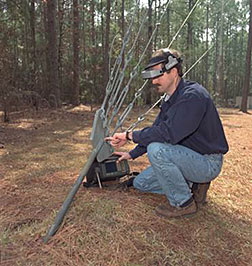- Number 409 |
- March 17, 2014
SRNL’s Sound Anchor represents new inspection tool

SRNL’s Sound Anchor
An inspection technique developed by two Savannah River National Laboratory researchers is ready for commercial use, via a license agreement signed with a Texas company.
SoundAnchor is a testing method developed at SRNL that uses ultrasonic technology to assess the structural integrity and safety of anchor rods that are used to stabilize large guyed towers. Metallurgical Engineering Services, Inc., a Richardson, Texas company, has signed an exclusive license to utilize SoundAnchorTM as an inspection tool.
Anchor rods are subject to below ground degradation that can lead to failure over time. Typically, anchor rods, if and when they are inspected, must be unearthed to allow for visual inspection. This can be costly, time consuming and can potentially destabilize the structure being anchored. Additionally, the excavation and reburial process is inherently damaging to the protective coatings on the rods.
Through a combination of equipment and technique, SoundAnchor allows rods to be examined in place via ultrasound, with the ultrasonic signals indicating any degradation along the length of the rod – even the portion of a rod encased in concrete block. This method requires no unearthing of the rod, eliminating the need for digging permits, excavation, shoring, and other cumbersome elements associated with current inspection methods. Estimates are that the cost of inspection could be reduced by as much as 90 percent, with broad application potential in the commercial radio, television, communication and cellular telephone industries.
SoundAnchor was patented based on work by William Hinz and Matthew J. Parker of SRNL. Parker, a meteorologist, and Hinz, a specialist in nondestructive testing, developed and refined the tool to inspect a network of nine towers used by the Lab’s Atmospheric Technologies group.
“There are tens of thousands of towers where this could be applied,” Parker said. “Any tower owner could benefit from a quick, less expensive method to verify that the anchoring is secure without having all of the many issues that go along with digging. This is a good example of a solution we developed and tested that can now have significant value for an industry.”[Will Callicott, 803.725.3786,
will.callicott@srnl.doe.gov]
